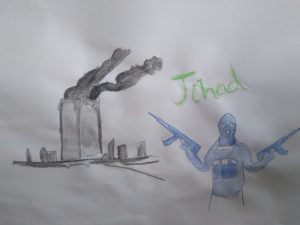Islam Vs The West
ø

Perceptions of Islam
Week 1 Response: Constructions and perceptions of Islam
Medium: Watercolors
In this illustration, I have painted a terrorist holding guns placed side by side to the twin towers which became the scene of a terrorist attack on 9/11. I have tried to portray the “clash of ignorance” as Agha Khan puts it. After the infamous 9/11 attack, the perception of Muslims became equivocal to that of terrorists in the West. I have tried to illustrate both sides painted with a single color representing each to emphasize how “people represent those different from themselves through simple caricatures, painting them with a single color and a single brush stroke, thus stripping them of their humanity” (Ways of Understanding Islam, Pg 3). Furthermore, I have added the term Jihad on the side of the terrorist to highlight how the terrorists in this case is ignorant about the true meaning of Jihad and how that’s a result of religious illiteracy. The misguided terrorist who on one hand might be completely ignorant of the myriad of factors (political, power plays by the elites/feudal classes who oppress the poor segments of their society) that contributed to his disillusionment with his and his family’s living situations, makes him amenable to attributing the cause of his and his people’s misfortunes to the West or unnamed people he is trained to terrorize and kill. In a way, his humanity has been robbed from him by a confluence of events and factors that he is not able to recognize and in the absence of widespread education that encourages critical thinking and questioning the root of our human problems, he is easily manipulated. “Religious Illiteracy can also provide the perfect breeding ground for extremism with religions” (Pg 3, Ways of Understanding Islam)
In response to the 9/11 attacks the West has become the symbolic hater of Islam considering the religion an ideology of terrorism. Because the terrorists associated themselves with Islam, the West has started attributing the actions of these terrorist organizations like Al-Qaeda to Islam as a religion. “With regard to understanding Islam and Muslim cultures, this leads to the perception that faith itself is responsible for the actions of all Muslims. It also leads to the assumption that whatever happened in a predominantly Muslim country can be attributed to Islam”.(Pg 4, Ways of Understanding Islam). What is considered “Islam” in the post-colonial world is dominated by the powerful groups in the Islamic world including the Saudi Wahabis (because of oil) and other gulf countries who have played a big role in sometimes disturbing and at the very least negatively influencing the traditions of South Asian Muslims for instance. In context of cultural studies approach, Ali Asani in his essay, “Ways of Understanding Islam” talks about how a group of Americans upon visiting the shrine of Khawaja Mooen ud din Chishti question why they haven’t seen this side of Islam, “If what we saw was Islam as it is understood by millions of Muslims in this part of the world, how is it that I didn’t know about it?”. This is because what these Americans observe is the “silent” Islam which does not get covered in the media and does not take a political stance like the “loud” Islam that the West is used to hating. The “loud” Islam has become an instrument to disillusion the West into believing that in Islam, the term Jihad is synonymous with war. Such simplification of Islam leads to “serve to dehumanize ‘the other’ and often lead to tragic consequences.” (Ways of Understanding Islam, Pg 5)

